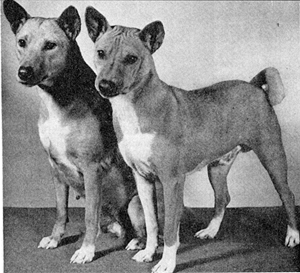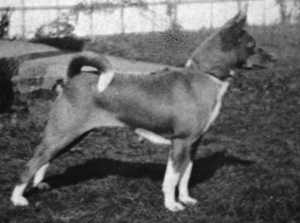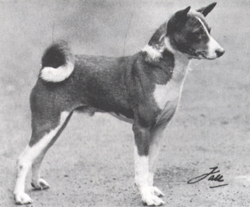Our present day stock all stems from a few dogs brought out
of Africa beginning in 1936. They should be divided into groups, namely
those from the upper reaches of the Congo River, those from the lower
Congo and those from Egyptian Sudan, known as the Zande Dogs. There was
one early import from Uganda, Simolo of the Congo. Miss Tudor-Williams
was responsible for this import but she did not care for the dog as he
matured and withdrew him from stud service. She informs me that none of
his blood came to America so I will ignore him in this report.
There were three dogs from the Lower Congo basin near the
west coast of Africa, namely Kindu
and Kasenyi who were
born to the north of Leopoldville and Phemister's
Congo, place of birth unknown but probably not far from
Leopoldville as she was found in the hold of a ship that arrived in
Boston in the spring of 1941. This bitch, Congo, was bred but once and
had three pups, two of which were later bred to other stock. I have a
record of the first 1,500 dogs registered by the American Kennel Club
and my studies indicate that the oldest living dog carrying this
bitch's blood has today less than one percent of the same. As she is no
longer a factor in our bloodlines I will drop her from consideration.

KINDU & KASENYI
In addition to these Belgian Congo dogs, we had, as of late 1963, a total of three dogs out of the southern Egyptian Sudan, namely: Amatangazig of the Congo; Wau of the Congo and Fula of the Congo.
|
|
|
Mrs.
Olivia Burn brought six Basenjis from the Upper Congo area between 1936
and 1938. She had spent seven years in the region and writes of her
experiences in the June 1937
issue of the American Kennel Gazette. This article is well
illustrated and the dogs pictured would do credit to the breed in
today's shows. These dogs were: Bongo;
Bereke; Bashele; Bungwa and Bakuma of Blean. I will
hereafter refer to them as the Blean dogs. Bakuma was bought while in
quarantine and went to America. He had a litter in America but the dam
and the pups all died. The Phemisters acquired Bakuma early in 1941 and
later registered him as Phemister's Bois.
Veronica
Tudor-Williams became interested in the breed almost from the start and
bought several pups from Mrs. Burn which she named with the suffix "of
the Congo". Some "Blean" dogs came to America starting in 1939 when Dr.
A. R. B. Richmond of Toronto, Canada, purchased a pair from V.T.W. Both
died and in 1940 he bought two more pairs, namely Kwillo of the Congo,
Koodoo of the Congo (males) and Kiteve of the Congo and Kikuyu of the
Congo (bitches). I went to Toronto late in June 1941 and saw the four
adult dogs as well as two litters born to them. I bought my first
Basenji at that time. For a while I thought I had the only one in the
U.S. but learned later of the two Phemisters' dogs and also of Kindu
and Kasenyi who arrived later the same year. I traveled to Boston and
saw Bois and Phemister's Congo. The latter had been bred to Koodoo of
the Congo and when I saw her she had a litter of three just a few days
old. I then traveled to New York City where I saw Kindu and Kasenyi
with a litter of five pups born on board ship, plus a young male of
another strain.
I refer to this male of another
strain. he did look very much like the Richmond dogs, Bois and other
Basenji I have seen over the years. The Kindu-Kasenyi combination and
their pups were considerably different. I was looking for a male for my
Tanya of Windrush but the only one of the New York dogs that interested
me was the unrelated young male. I would have bought him but the man in
charge told me that he was of uncertain temperament.
The Kindu blood did not make itself felt until a few years
later. Therefore our early American Basenjis were made up of a
combination of Blean and "of the Congo" stock containing the
Amatangazig blood. Kindu was bred to Blean dogs twice and to Kasenyi
once in the states. He bred her again in Hawaii but only one dog was
registered. Several years after his arrival he and Kasenyi had a litter
among which was Kingolo and Kasenyi. These two were bred later and the
Phemisters bought one of the pups, Kingolo's Kontender. He was used at
stud many times. Kingolo went to Ireland after 1950 and some of his
blood has since come back to the U.S.
To sum up,
it is my opinion, based on extensive studies of the pedigrees, that up
to recent years our bloodlines in America are about 45% Blean; 45% "of
the Congo" from Amatangazig, Wau and Fula, and 10% Kindu-Kasenyi. It
appears that as the years pass the percentage will lean more to the
Zande blood and less to the Blean with the Kindu blood going still
lower.
Regardless of their early background, I
believe that all of the contributors to our bloodlines have added
something worthwhile and I further believe that many of our earliest
dogs would do well in the ring today, but that the percentage of top
quality dogs is steadily on the increase due to selective breeding.

